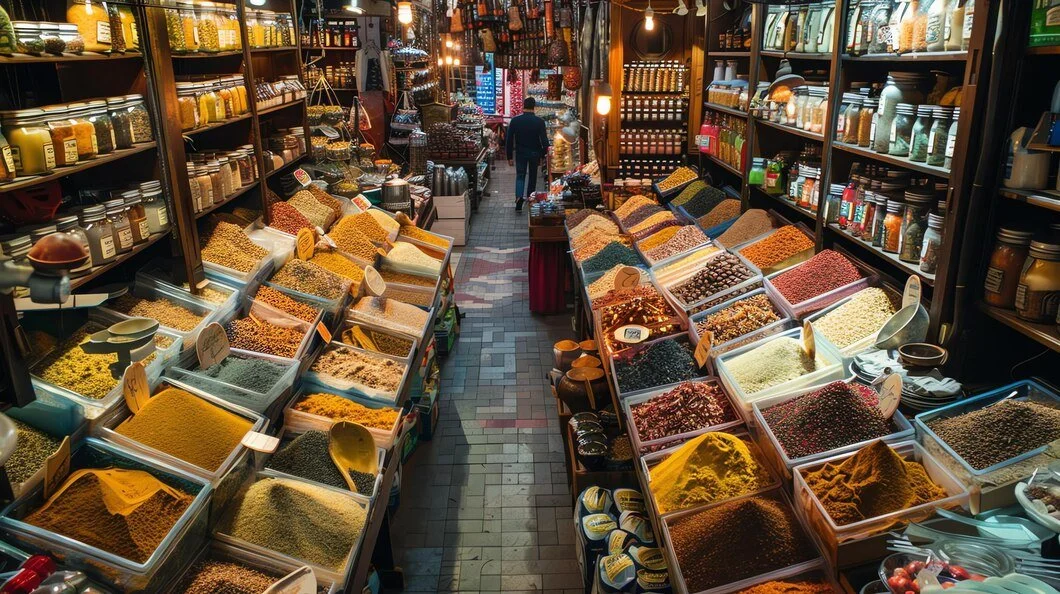Lost & Found in India’s Khari Baoli Spice Market
Nestled in the heart of Old Delhi, Khari Baoli stands as a fragrant testament to India’s rich history and culinary traditions. As Asia’s largest spice market, this iconic destination offers more than just spices; it provides a sensory journey through centuries of cultural and historical evolution. Its story, deeply intertwined with Delhi’s legacy, beckons travelers and food lovers alike to explore its vibrant alleys.
Unpacking the Name
The name “Khari Baoli” carries a story within itself. It comprises two elements: “Khari,” meaning salty or brackish, and “Baoli,” which refers to a stepwell. Stepwells, or baolis, were integral to ancient Indian communities as water reservoirs and social gathering spots. Beyond their practical use, these architectural marvels often held cultural and religious significance, with some even transforming into temples over time. While stepwells once dotted the Indian subcontinent, the finest examples are preserved in regions like Rajasthan, Gujarat, and Delhi.
The term “Khari” alludes to the saline nature of the water in the original stepwell. As water levels receded, the stepwell ceased to function as a water source and instead became a bustling hub for trade. Over time, Khari Baoli evolved into the vibrant marketplace we know today, celebrated for its incredible array of spices, herbs, and culinary treasures.
A Historical Treasure
Khari Baoli’s roots trace back to an era preceding the reign of Mughal Emperor Shah Jahan, who famously commissioned the nearby Red Fort. This market’s long-standing presence makes it a living museum of Delhi’s trade and cultural exchanges over centuries. Once a modest trading area, it has grown into a sprawling market that attracts traders and customers from across India and beyond.
One fascinating tidbit is that Khari Baoli’s prominence in the spice trade can be linked to India’s historical role as a global supplier of spices. Spices were as valuable as gold during ancient times, driving explorers and traders to India’s shores. Today, Khari Baoli continues this legacy, supplying spices not only to local households but also to international markets.
A Feast for the Senses
Stepping into Khari Baoli is like entering a kaleidoscope of colors, aromas, and sounds. The narrow lanes are lined with shops brimming with everything from vibrant red chilies and golden turmeric to fragrant cardamom and earthy cumin. The heady aroma of spices fills the air, mingling with the chatter of traders and the occasional clang of metal scoops as spices are measured and bagged.
But Khari Baoli is not just about spices. The market also offers staples like rice, pulses, tea, and dried fruits. Adventurous visitors can discover Ayurvedic and Unani herbal remedies tucked away in small, unassuming shops. These traditional medicines, derived from centuries-old practices, are said to offer cures for everything from digestive issues to insomnia.
Insider Tips for Visitors
For those planning to visit Khari Baoli, a little preparation can go a long way in enhancing the experience. Here are some tips to make the most of your trip:
Timing is Key: The market operates from 10 am to 8 pm, but it’s best to visit during the cooler months of winter to avoid Delhi’s sweltering heat. The market sees a lull between 2 pm and 4 pm, offering a quieter time to explore without the usual hustle and bustle.
Comfortable Clothing and Footwear: The alleys of Khari Baoli can be narrow and crowded, so wear comfortable shoes and light clothing to navigate the market with ease.
Engage with the Vendors: Many shopkeepers are knowledgeable about their wares and happy to share recipes or tips on using spices. Don’t hesitate to ask questions or seek recommendations.
Try Before You Buy: Sampling is part of the experience. Whether it’s a pinch of saffron or a handful of dried fruits, tasting the products ensures you’re getting the best quality.
Hidden Gems and Must-Buys
While the market is teeming with delights, there are a few standout items worth taking home:
Saffron: Known as “red gold,” Indian saffron is prized for its flavor and color. Be sure to purchase from a trusted vendor to ensure authenticity.
Garam Masala: This quintessential Indian spice blend is a must-have for any home cook looking to recreate authentic Indian dishes.
Dried Fruits and Nuts: Khari Baoli offers an impressive selection of dried apricots, pistachios, and almonds sourced from regions like Kashmir and Afghanistan.
Ayurvedic Herbs: From ashwagandha to turmeric supplements, these herbs make for unique and health-boosting souvenirs.
Cultural Significance in Modern Times
Khari Baoli is more than a market; it’s a microcosm of India’s culinary and cultural heritage. It serves as a meeting point for traders from diverse backgrounds, all united by their love of spices and trade. The market’s enduring charm has even made its way into popular culture, with its vibrant alleys immortalized in Bollywood films like "Sultan" (2016).
